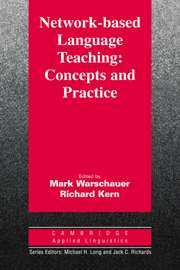Book contents
- Frontmatter
- Contents
- List of contributors
- Series editors' preface
- Preface
- 1 Introduction: Theory and practice of network-based language teaching
- 2 Sociocollaborative language learning in Bulgaria
- 3 On-line learning in second language classrooms: An ethnographic study
- 4 Negotiation in cyberspace: The role of chatting in the development of grammatical competence
- 5 Writing into change: Style shifting in asynchronous electronic discourse
- 6 Computers and collaborative writing in the foreign language curriculum
- 7 Networked multimedia environments for second language acquisition
- 8 An electronic literacy approach to network-based language teaching
- 9 Task-based language learning via audiovisual networks: The LEVERAGE project
- 10 Is networked-based learning CALL?
- Name index
- Subject index
6 - Computers and collaborative writing in the foreign language curriculum
Published online by Cambridge University Press: 05 October 2012
- Frontmatter
- Contents
- List of contributors
- Series editors' preface
- Preface
- 1 Introduction: Theory and practice of network-based language teaching
- 2 Sociocollaborative language learning in Bulgaria
- 3 On-line learning in second language classrooms: An ethnographic study
- 4 Negotiation in cyberspace: The role of chatting in the development of grammatical competence
- 5 Writing into change: Style shifting in asynchronous electronic discourse
- 6 Computers and collaborative writing in the foreign language curriculum
- 7 Networked multimedia environments for second language acquisition
- 8 An electronic literacy approach to network-based language teaching
- 9 Task-based language learning via audiovisual networks: The LEVERAGE project
- 10 Is networked-based learning CALL?
- Name index
- Subject index
Summary
Not long ago, as the technological revolution began accelerating at an astounding rate, a number of humanists admonished their more reticent colleagues to put aside their misgivings about the educational potential of the computer and to begin integrating technology into their approaches to teaching. Some scholars argued that the humanities, by not implementing new technologies, ran the risk of increasing obsolescence (see Herron & Moos, 1993, p. 479). Partially on this basis, Richard Lanham (1993) argues strenuously for the integration of computers into the humanities, and particularly into the writing curriculum, noting that “The students we teach are going to do most of their writing and much of their reading on an electronic screen. They are going to live they live now in a world of electronic text” (p. 121).
As Lanham suggests, one of the most compelling areas of exploration for computer use is in the field of foreign language writing. Part of this attention derives quite naturally from the English composition curricula from which the teaching of foreign language writing takes its cue. With the advent of the word processor, the teaching of writing has drastically changed, making the radical revision of a text possible with a few keystrokes. This technological ease of revision has in turn served to bolster the parallel shift in the teaching of writing from an end-product approach, where the teacher alone reads and comments on papers students have written without the benefit of feedback on a rough draft, to a process approach, where students work in small groups of peers for suggestions for multiple drafts, subsequently revising their papers before finally handing them in to the teacher.
- Type
- Chapter
- Information
- Network-Based Language Teaching: Concepts and PracticeConcepts and Practice, pp. 121 - 150Publisher: Cambridge University PressPrint publication year: 2000
- 25
- Cited by

